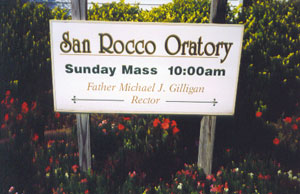 | This sign is posted in front of the church building.
|
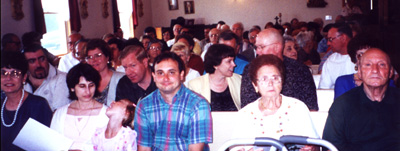 | Sunday
Assembly at San Rocco Oratory. Above, first row, from the left, Jean,
Rosanne, & Greg Ciambrone, Maria & Ray Planera. Second row, from
the left, Nick Markionni, Donna & Rick Thiernau, Pat & Bob
Barker, Gene LaBelle, & Annette Nordstrom (obscured).
|
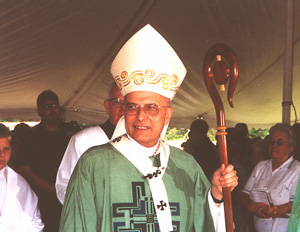 | Here is Cardinal George, processing through the congregation, on August 26, 2001. It is the beginning of the liturgy.
|
 | A parish of 2400 families, with five Sunday Masses: St. Francis of Assisi, Orland Hills, Illinois.
|
Te igitur, clementissime Pater, per Iesum Christum, Filium tuum, Dominum
nostrum, supplices rogamus ac petimus, uti accepta habeas et benedicas +
haec dona, haec munera, haec sancta sacrificia illibata, in
primis, quae tibi offerimus pro Ecclesia tua sancta catholica quam
pacificare, custodire, adunare et regere digneris toto orbe
terrarum: una cum famulo tuo Papa nostro [Benedicto] et Antistite nostro [Francesco] et omnibus orthodoxis atque catholicae et apostolicae fidei cultoribus.
For detailed study of this phrase, orthodoxis cultoribus, see the historical work of Father Joseph Jungmann.
|
Sunday Mass: 10 a.m.
What is the Church?
Each
Sunday, there is only one "assembly," one gathering of the people of
the San Rocco community. That is the ideal of the Sunday
Eucharist, the Mass, especially inasmuch as it gave rise to the word
"ecclesia" in both Greek and Latin, as well as "chiesa" in
Italian. The word means much the same thing as "assembly" in a
grade school, namely, a gathering of all the students. In this
case, the Sunday gathering, also called a congregation, is the very name
of the people, that is, the "ecclesia," the "Church." In this
sense, then, the Church is primarily the Sunday gathering, in communion
with the bishop of the diocese, Cardinal George, who is in communion
with all the bishops of the Catholic Church and especially the bishop of
Rome, Pope John Paul.
Many Roman Catholic parishes in the U.S.
are too large to accommodate all the people in one gathering; so, they
have to schedule two or more Masses on Sunday. To the disadvantage
of the community, the people therefore become separated and do not
know each other. While often necessary, this situation is less
than ideal. When there is more than one Sunday Mass in a
parish, it is impossible to compensate for that, for example, by having
coffee and donuts after a celebration. There is no substitute for
the Church itself, the normal Sunday gathering of all the people in a
given community.
In contrast to general practice in the
U.S., Eastern Catholic and Orthodox churches still maintain the norm of
only one Eucharist per day, on one altar. In the West, since
ancient times, we compromised this norm by having more than one Mass on
such feastdays as Christmas and Easter, when there were more people
present. In time, we came to expand the number of Masses on more
and more Sundays. As time went on, we in the West came to forget
our own tradition, which is still in force in the Eastern
Churches. So, we came to go to Mass as individuals rather than as
members of a family. Sadly, in many Western churches, there is no
Sunday assembly, no single celebration of the Eucharist, and hence no
community in the traditional sense.
Sunday Mass at San Rocco The Archdiocese of Chicago has its own set of policies for Sunday Mass.
In general, these policies reflect the general law and customs of the
Roman Rite; these policies all apply to the Eucharist celebrated at
the oratory.
At San Rocco, as in many small parishes, people do
know one another. When someone is sick, all the members pray for
that person together. When someone recovers, all the members
rejoice together. When someone is away, that person is
missed. In his epistles, St. Paul spoke of this kind of unity, as
that of the Body of Christ, member for member. It can be expressed
sacramentally, in a single Sunday celebration of the Eucharist, the
Divine Liturgy, often called the Mass. Through that sacramental
expression, the Church, the ecclesia, is built up and made strong. If
you are a visitor to San Rocco, you will notice that people sing much
of the liturgy by heart. They know the songs from memory.
That's because most of the Mass is familiar to the people, especially
the normal acclamations and responses: - Kyrie, eleison.
- Thanks be to God.
- Alleluia. Alleluia. Alleluia.
- Praise and Honor to you, Lord Jesus Christ.
- Glory to you, Lord.
- Praise to you, Lord Jesus Christ.
- Lord, we beg you, hear our prayer.
- To you, O Lord our God.
- Blest be God. Blest be God.
- Blest be God forever.
- And also with you.
- We lift them up to the Lord.
- It is right to give him thanks and praise.
- Sanctus.
- Christ Has Died.
- Great Amen.
- Praise God from Whom All Blessings Flow.
- For the Kingdom, the power and the glory are yours.
- Agnus Dei.
- Thanks be to God.
- Thanks be to God. Alleluia, Alleluia.
From
Sunday to Sunday, these songs are much the same, so that everyone can
join in, easily and freely. Since these songs are acclamations, they are
never recited; they are always sung.
Fully Catholic As
Catholic, the San Rocco community is in communion with its bishop,
Cardinal George; in this way, the Oratory is part of the Archdiocese of
Chicago, the local Church, and therefore of the universal Church.
This communion means that we do our best to understand the teaching and
the leadership of our bishop and to implement his intentions for our
benefit. He is the one who sends a priest in his stead, whether
that priest is Most Rev. Joseph Perry or Father Gilligan or someone
else.
He is the one who locally fully takes the place of the
apostles and sustains for us the tradition of the apostolic faith.
He is the one who maintains our communion with the wider Church,
including the Pope of Rome. The bishop is the first minister of
the three sacraments of initiation, baptism, confirmation, and first
holy Communion; either he or someone he sends is to preside at these
sacraments. An auxiliary bishop or priest, then, cannot act except
in communion with his bishop, who is the chief shepherd of the
flock. Whenever the sacraments are celebrated, they are always
carried out in communion with our bishop. We
are called Roman Catholic for two reasons. First, our bishop,
Cardinal George, is in communion with the Bishop of Rome. Second,
we use the Roman Rite, the liturgy of most of the Western Church.
Episcopalians and Lutherans, for the most part, use the same rite; but
they are not Roman Catholic and do not so identify themselves.
Although their liturgy is much the same as ours, they are not in
communion with us or with Rome; there are still doctrinal differences
that need to be resolved.
Fully Orthodox As
Orthodox, the San Rocco community treasures its tradition of the faith
given to us by the apostles, preached and recorded in the New Testament,
expounded by the Fathers of the Church, and proclaimed in the decisions
of the Ecumenical Councils. Especially in the first
seven councils, the bishops of the whole world gathered and, in
response to challenges, clarified the Orthodox faith. It is this
common inheritance, guided by the Holy Spirit, that today unifies the
Catholic and the Orthodox Churches and helps bring them to a deeper
communion as time goes on.
For example, Catholic and Orthodox
Churches share the same texts of the Bible, the same teaching of the
Fathers of the Church, the same sacraments, traditionally counted
as seven, and the same articles of faith, expressed in creeds and in
doctrinal statements of the Ecumenical Councils. These Churches,
together, share similar veneration for the Virgin Mary, pray for the
dead, and esteem the intercession of the saints. They hold in
reverence icons, statues, and other objects of devotion. As a
matter of custom, varying from place to place, they make the sign of the
cross, professing belief in the Trinity; they use incense,
holy water, candles, blest palms, and other sacramentals. They
respect monastic life, for both men and women, people who live in
community and dedicate their days to prayer and work. They do
penance, fast, and promote justice for all. They consecrate the world by
dedicating their daily work to Christ, living in accord with his
Gospel. They support the pro-life cause, defending unborn children,
elderly people, and those who are disabled in any way. Most important of
all, from the rising of the sun to its setting, they celebrate the
Eucharist, Sunday after Sunday, so that a perfect offering may be made
to the glory of God's Name.
In the ancient Roman Canon, which
dates in large part from the fourth century, we pray explicitly for the
Orthodox bishops who "cultivate" the Catholic and Apostolic faith, who
preserve it, preach it, and pass it on. We know this prayer today
as the first Eucharistic Prayer; it bears witness to what we believe and
what we celebrate, down to the present day.
|







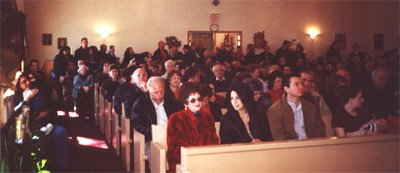
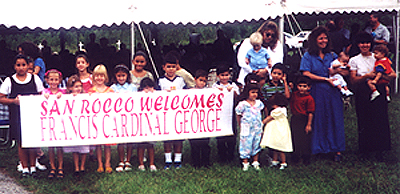
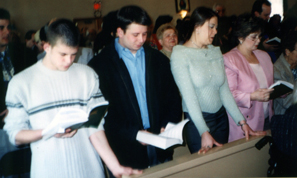
 top
top